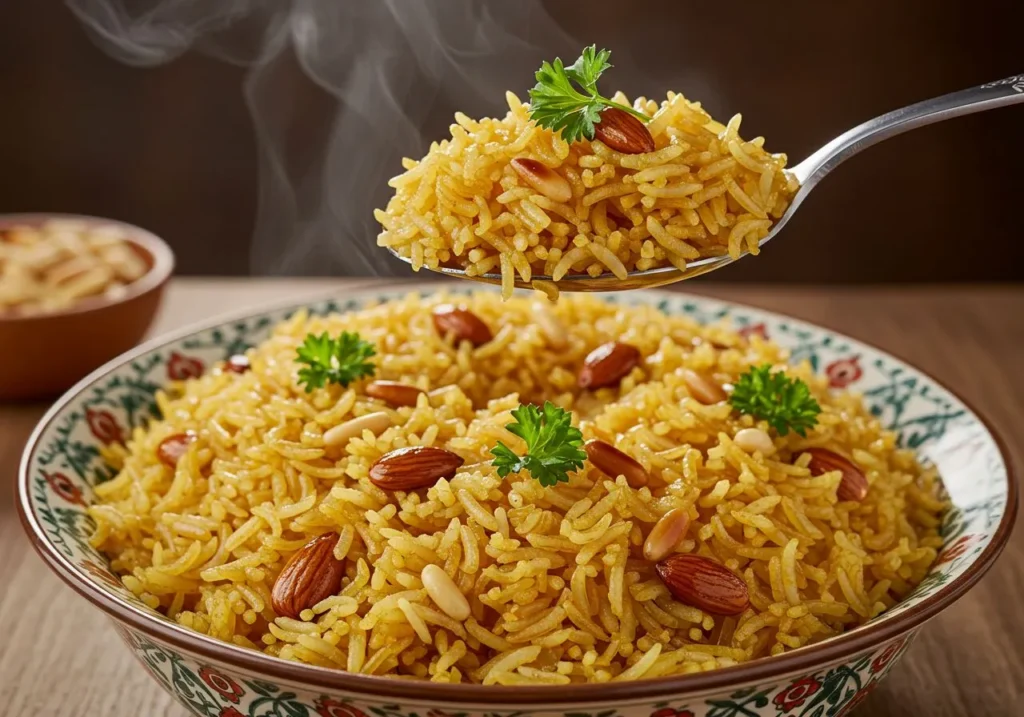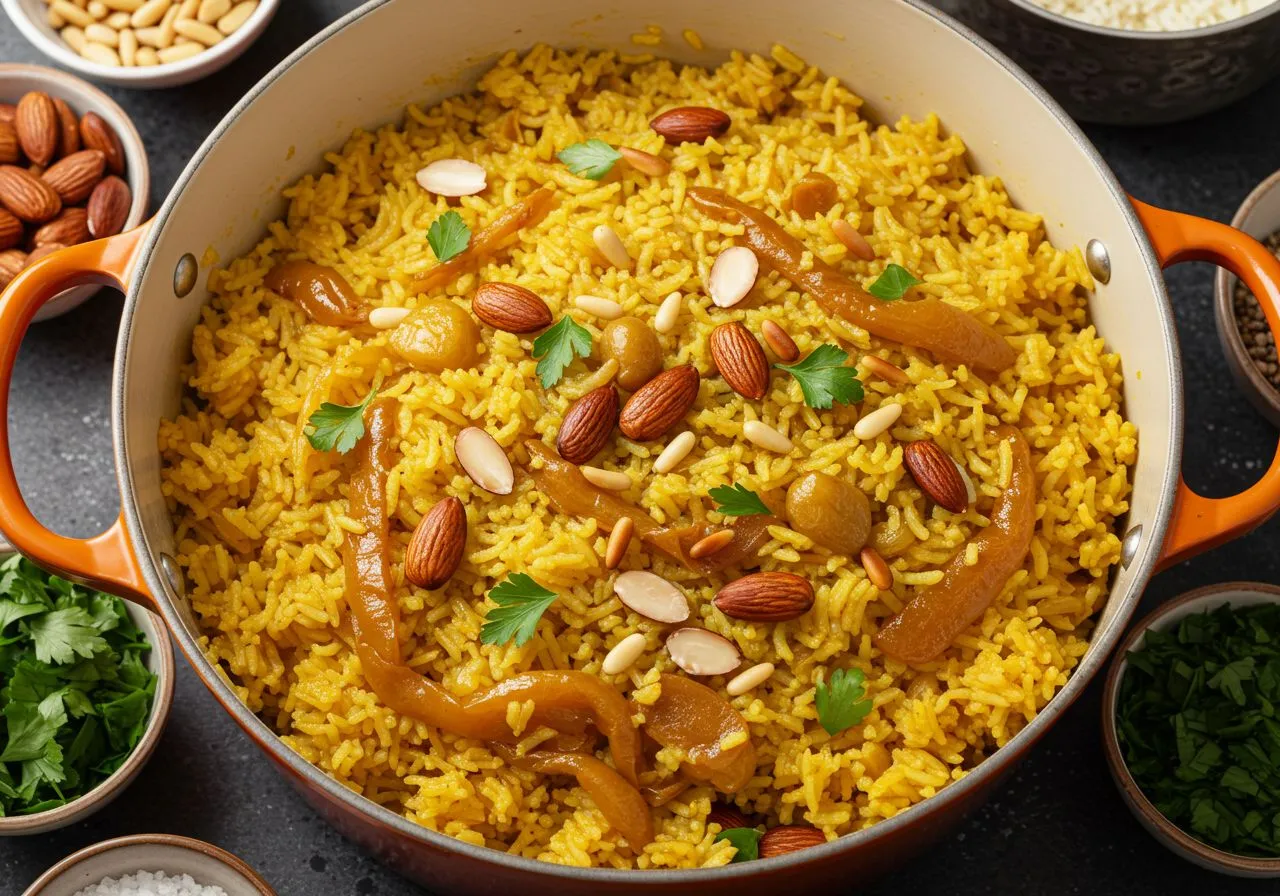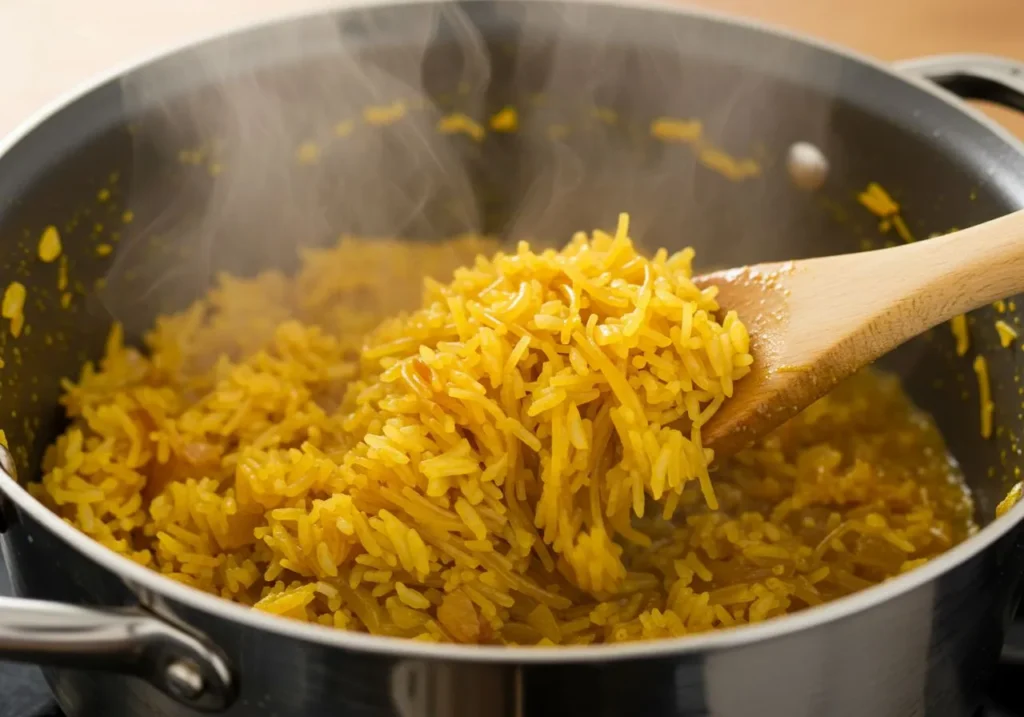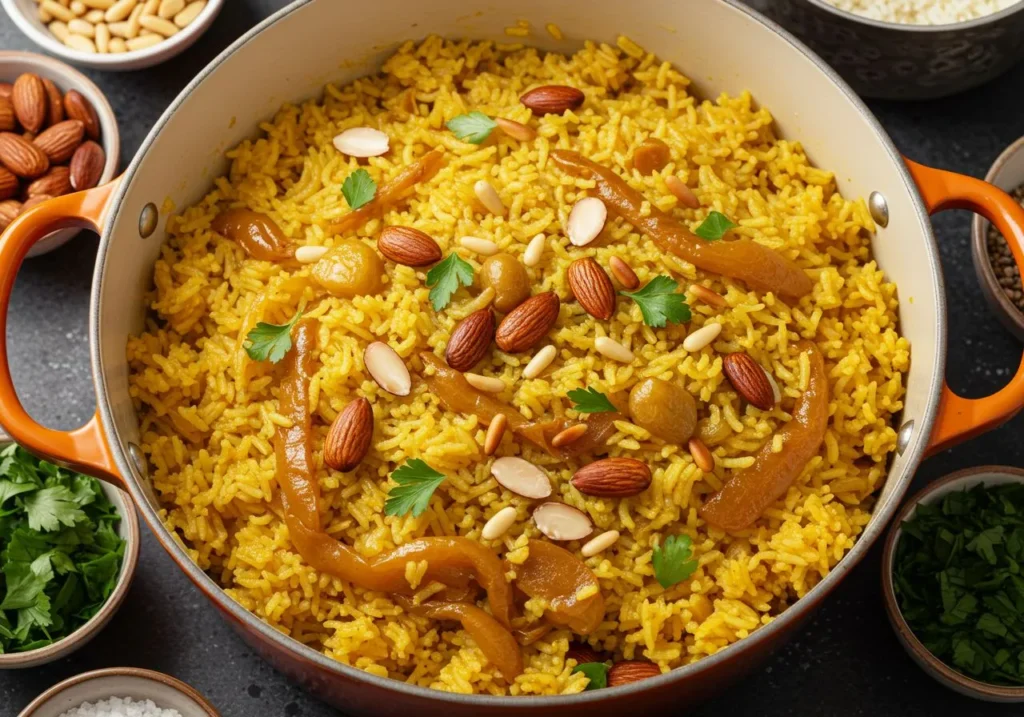
Table of Contents
Published: January 2025 | Prep Time: 10 minutes | Cook Time: 25 minutes | Serves: 6
There’s something magical about the way my mother could transform simple ingredients into the most aromatic, flavorful rice dish I’d ever tasted. Growing up in our Lebanese-American home, her Arabic rice pilaf was the foundation of nearly every dinner. The secret, she would tell me years later, wasn’t just in the spices – it was in the love, the technique, and the way she adapted her grandmother’s traditional recipe to work with American ingredients and busy family schedules.
This Arabic Rice Pilaf with American Twist has become my signature side dish, and I’m excited to share it with you today. It combines the warm, aromatic flavors of traditional Middle Eastern rice with the convenience and ingredients readily available in any American grocery store. The best part? It all comes together in just one pot, making cleanup a breeze – something my busy American lifestyle definitely appreciates!

Arabic Rice Pilaf with an American Twist
This Arabic Rice Pilaf brings together toasted vermicelli, warm Middle Eastern spices, and basmati rice in one comforting, one-pot dish. With easy-to-find ingredients and foolproof technique, it’s an authentic recipe adapted for modern American kitchens.
Ingredients
Instructions
- 1Heat oil in a large pot. Toast broken vermicelli noodles over medium heat until golden brown (3-4 minutes).
- 2Add rinsed basmati rice and stir to coat in oil. Toast for 2 minutes. Add cumin, coriander, turmeric, cardamom, cinnamon, and black pepper. Cook for 30 seconds until fragrant.
- 3Pour in broth. Add bay leaf, cinnamon stick, and salt. Bring to a rolling boil over high heat.
- 4Reduce heat to low, cover tightly, and simmer for 18 minutes. Turn off heat and let sit, covered, for 5 minutes.
- 5While rice rests, toast nuts in a dry skillet until golden. Fluff rice, remove bay leaf and cinnamon stick, dot with butter, then top with nuts, raisins (optional), and parsley.
- 6Serve warm or at room temperature. Store leftovers in an airtight container.
Why This Arabic Rice Pilaf Will Become Your Go-To Side Dish
Let me share why this recipe has earned a permanent place in my weekly meal rotation:
- Incredible aroma: Your entire house will smell like a Lebanese kitchen
- Perfect texture: Each grain of rice is separate and fluffy, never mushy
- Versatile pairing: Complements everything from grilled chicken to roasted vegetables
- One-pot wonder: Minimal cleanup with maximum flavor
- Budget-friendly: Feeds 6 people for less than $5
- Make-ahead friendly: Actually tastes better the next day
- Authentic taste with American convenience: Traditional flavors using easy-to-find ingredients
Essential Ingredients
For the Rice Base:
- 2 cups long-grain basmati rice (jasmine rice works too)
- 3 tablespoons olive oil or vegetable oil
- 1/2 cup vermicelli noodles, broken into 1-inch pieces (found in pasta aisle)
- 3 1/2 cups chicken broth (or vegetable broth for vegetarian option)
- 1 bay leaf
- 1 cinnamon stick
- 1/2 teaspoon salt (adjust based on broth saltiness)
For the Arabic Flavor Profile:
- 1/2 teaspoon ground cumin
- 1/4 teaspoon ground coriander
- 1/4 teaspoon turmeric (for beautiful color)
- 1/4 teaspoon cardamom (optional but highly recommended)
- 1/8 teaspoon cinnamon
- Pinch of black pepper
For the Garnish and Texture:
- 1/3 cup slivered almonds
- 1/4 cup pine nuts (substitute with chopped almonds if unavailable)
- 1/4 cup golden raisins (optional, adds traditional sweetness)
- 2 tablespoons fresh parsley, chopped
- 1 tablespoon butter (for extra richness)
Step-by-Step Cooking Instructions
Step 1: Prepare and Toast the Vermicelli (5 minutes)
This step is crucial for authentic flavor and texture. Heat the oil in a large, heavy-bottomed pot or Dutch oven over medium heat. Add the broken vermicelli noodles and cook, stirring constantly, until they turn golden brown – about 3-4 minutes. Watch carefully as they can go from golden to burnt very quickly!
The toasted vermicelli will give your rice that distinctive nutty flavor and beautiful golden color that makes Arabic rice pilaf so special.
Step 2: Add Rice and Spices (3 minutes)
Add the rice to the pot with the toasted vermicelli. Stir gently to coat each grain with the oil and toast the rice for about 2 minutes. You’ll hear gentle sizzling – this is perfect!
Add all your spices (cumin, coriander, turmeric, cardamom, cinnamon, and black pepper) and stir for another 30 seconds until fragrant. The kitchen should start smelling absolutely incredible at this point.

Step 3: Add Liquid and Seasonings (2 minutes)
Carefully pour in the chicken broth (it will bubble vigorously at first). Add the bay leaf, cinnamon stick, and salt. Stir once to combine everything evenly.
Bring the mixture to a rolling boil over high heat. This should take about 2-3 minutes.
Step 4: Simmer to Perfection (18 minutes)
Once boiling, reduce the heat to the lowest setting and cover tightly with a lid. Cook for exactly 18 minutes without lifting the lid – I know it’s tempting, but resist! The steam needs to stay trapped to cook the rice properly.
After 18 minutes, remove from heat but keep the lid on. Let it rest for 5 minutes – this final steaming step ensures perfect texture.
Step 5: Toast the Nuts and Final Touches (5 minutes)
While the rice rests, quickly toast the almonds and pine nuts in a dry skillet over medium heat until golden brown, about 2-3 minutes. Watch carefully as nuts can burn quickly.
After the 5-minute rest, remove the lid from the rice pot and gently fluff the rice with a fork. Remove the bay leaf and cinnamon stick. Dot the top with butter and let it melt into the rice.
Step 6: Garnish and Serve
Sprinkle the toasted nuts, golden raisins (if using), and fresh parsley over the rice. Serve immediately while hot, or let it cool slightly – it’s delicious either way!

Professional Tips for Perfect Arabic Rice Pilaf
Rice Selection and Preparation:
- Choose the right rice: Basmati is ideal for its long grains and aromatic quality
- Rinse until clear: Wash rice in cold water until the water runs clear to remove excess starch
- Don’t skip the vermicelli: It’s not optional – it provides authentic texture and flavor
- Toast for flavor: The toasted vermicelli and rice create the distinctive nutty taste
Cooking Technique Secrets:
- Heavy-bottomed pot: Ensures even heat distribution and prevents burning
- Perfect liquid ratio: 1 3/4 cups liquid per 1 cup rice works best
- No peeking rule: Keep the lid on during cooking for proper steam circulation
- Rest period: The 5-minute rest with lid on is crucial for perfect texture
Flavor Enhancement Tips:
- Quality broth: Use good chicken or vegetable broth instead of water
- Whole spices: Bay leaf and cinnamon stick add deeper flavor than ground versions
- Fresh herbs: Add parsley just before serving for bright color and flavor
- Butter finish: A tablespoon of butter stirred in at the end adds richness
Nutritional Information (Per Serving)
- Calories: 285
- Carbohydrates: 48g
- Protein: 7g
- Fat: 8g
- Fiber: 2g
- Sodium: 420mg
This rice pilaf provides complex carbohydrates, healthy fats from nuts, and essential nutrients from the herbs and spices.
Storage and Reheating Instructions
Proper Storage:
- Refrigerator: Store in airtight container for up to 5 days
- Freezer: Freeze portions for up to 3 months
- Room temperature: Safe for up to 2 hours after cooking
Reheating Methods:
- Microwave: Add 1-2 tablespoons of water, cover, heat 1-2 minutes
- Stovetop: Add splash of broth, heat gently while stirring
- Oven: Cover with foil, reheat at 350°F for 15-20 minutes
Variations and Customizations
Protein Additions:
- Chicken pilaf: Add diced cooked chicken in the last 5 minutes
- Lamb version: Stir in leftover roasted lamb
- Seafood twist: Add cooked shrimp just before serving
Vegetable Variations:
- Mediterranean style: Add sun-dried tomatoes and olives
- Persian influence: Include barberries and saffron
- American fusion: Mix in roasted bell peppers and corn
Dietary Modifications:
- Vegan: Use vegetable broth and omit butter
- Gluten-free: Substitute rice noodles for vermicelli
- Lower sodium: Use low-sodium broth and adjust salt
- Keto-friendly: Replace with cauliflower rice (cooking time will differ)
Seasonal Adaptations:
- Fall version: Add diced butternut squash and cranberries
- Spring style: Include peas and fresh mint
- Summer variation: Mix in cherry tomatoes and fresh basil
- Winter comfort: Add root vegetables and warm spices
 DINNER
DINNER  LUNCH
LUNCH  CAKE
CAKE  BREAKFAST
BREAKFAST For more amazing recipes, be sure to check out our other sections to explore a variety of ideas that will enrich your cooking experience. Each section offers its own unique flavors to ensure a delightful culinary journey:
- Easy and Quick Recipes: A collection of dishes that guarantee delicious meals with minimal effort and time.
- Healthy Recipes: Discover healthy and delicious options that fit your lifestyle.
- Desserts: A diverse selection of sweets that will add a special touch of sweetness to your table.
- Lunch Recipes: Tasty lunch ideas that you can easily prepare to delight your family.
- Dinner Recipes: Delicious and easy-to-make recipes that will make your dinner a memorable occasion.
Frequently Asked Questions
Q: Can I use jasmine rice instead of basmati?
A: Yes! Jasmine rice works well and is often easier to find. The texture will be slightly different but still delicious. Use the same cooking method and timing.
Q: What if I can’t find vermicelli noodles?
A: Look for thin spaghetti or angel hair pasta in the pasta aisle and break it into small pieces. Some stores carry “vermicelli rice” in the international section which works perfectly.
Q: Why is my rice mushy or sticky?
A: This usually happens from too much liquid, not rinsing the rice, or cooking at too high heat. Make sure to rinse rice until water runs clear and keep heat low during simmering.
Q: Can I make this recipe in a rice cooker?
A: You’ll miss the authentic toasted vermicelli flavor, but you can add pre-toasted vermicelli and spices to your rice cooker with the liquid. Results may vary by rice cooker model.
Q: How do I know when the rice is properly cooked?
A: After the rest period, the rice should be fluffy with separate grains. If it seems slightly underdone, let it rest longer with the lid on. The residual heat will finish the cooking.
Q: Can I make this ahead for meal prep?
A: Absolutely! This rice actually develops better flavor overnight. Store in portions and reheat with a splash of broth to refresh the moisture.
Q: What’s the difference between this and regular rice pilaf?
A: Arabic rice pilaf specifically includes the toasted vermicelli, warm Middle Eastern spices, and often nuts and raisins. It has a more complex flavor profile than basic rice pilaf.
Q: Is this recipe authentic to Lebanese cuisine?
A: Yes, this represents traditional Lebanese rice preparation adapted for American kitchens. The vermicelli and spice combination are authentic, while the American twist involves using readily available ingredients.
The Cultural Significance
In Lebanese culture, rice isn’t just a side dish – it’s the foundation of the meal. This particular style of rice pilaf, called “riz bi sha’riyeh” in Arabic, is served at every important gathering, from casual family dinners to elaborate wedding feasts.
The toasted vermicelli isn’t just for flavor – it represents the care and time that goes into proper cooking. In traditional Lebanese kitchens, nothing is rushed, and every ingredient is treated with respect. The act of carefully toasting the vermicelli until perfectly golden is almost meditative, a moment of mindfulness in the cooking process.
When Lebanese families immigrated to America, they brought these recipes with them, adapting them to new ingredients and time constraints while maintaining the essential character that makes them special. This rice pilaf recipe embodies that beautiful balance between honoring tradition and embracing practical modern cooking.
Perfect Pairings and Menu Ideas
This Arabic Rice Pilaf pairs beautifully with:
Mediterranean Menu:
- Grilled lamb chops with herbs
- Roasted eggplant with tahini
- Fresh cucumber yogurt salad
American Fusion Dinner:
- Herb-crusted chicken breast
- Roasted seasonal vegetables
- Simple green salad with lemon vinaigrette
Middle Eastern Feast:
- Lebanese Chicken Shawarma Bowls
- Homemade hummus and pita
- Grilled vegetables with za’atar
Vegetarian Options:
- Stuffed bell peppers
- Roasted portobello mushrooms
- Mediterranean chickpea salad
Why This Recipe Works So Well in American Kitchens
After years of adapting traditional Lebanese recipes for American cooking, I’ve learned what makes a recipe truly successful in modern kitchens:
- Ingredient accessibility: Every component is available in standard grocery stores
- Time efficiency: One pot, 35 minutes total time
- Familiar techniques: Uses standard American cooking methods
- Family-friendly: Appeals to both adventurous and cautious eaters
- Meal prep compatible: Stores and reheats beautifully
- Scalable: Easy to double or halve for different family sizes
Related Middle Eastern Fusion Recipes
If you love this Arabic Rice Pilaf, you’ll also enjoy:
- Lebanese Chicken Shawarma Bowls – Perfect protein pairing
- Za’atar Roasted Vegetables – Complementary side dish
- Middle Eastern Stuffed Bell Peppers – Use this rice as stuffing
- Homemade Hummus – Classic appetizer to start the meal
Final Thoughts
This Arabic Rice Pilaf with American Twist represents everything I love about fusion cooking – it honors the traditional flavors and techniques that have been passed down through generations while embracing the practical needs of modern American life.
The combination of toasted vermicelli, aromatic spices, and perfectly cooked rice creates something truly special. It’s comfort food that tells a story, connects us to culture, and brings families together around the dinner table.
Whether you’re new to Middle Eastern flavors or looking to expand your side dish repertoire, this rice pilaf will become a beloved addition to your recipe collection. The technique might seem a bit different from regular rice cooking, but once you taste the results, you’ll understand why this method has been cherished for generations.
Take your time with the toasting, be patient with the simmering, and most importantly, share this beautiful dish with people you love. That’s the true secret ingredient in any Lebanese recipe.
Sahtayn! (Double health – the traditional Lebanese blessing before eating!)
Don’t forget to share your Arabic Rice Pilaf creations with us on social media – we love seeing how our recipes bring joy to your kitchen!
